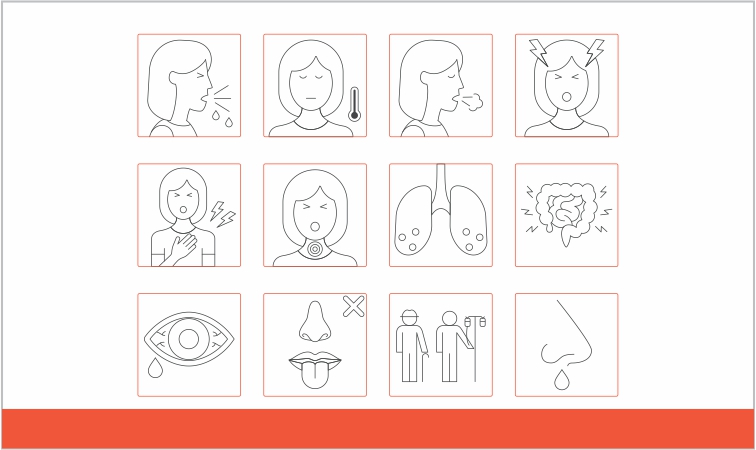COVID 2nd Wave: What are The New Symptoms?

Individuals infected with the novel Coronavirus have experienced a wide range of symptoms, ranging from mild to moderate to serious. New and unusual signs are being found in newly infected patients as the virus changes its type rapidly and new forms are identified. COVID-19 is currently causing a second wave in India, and the virus is said to be more contagious than before. It is therefore important that you are aware of the most recent COVID-19 symptoms to recognize them, receive prompt care, and prevent complications.
New signs and symptoms of Covid-19 in the second wave
One of the first signs of coronavirus infection is shortness of breath or trouble breathing (dyspnea), which is most often seen in infected patients during the second wave of COVID-19. Breathing problems seem to be normal in the second wave of COVID-19 patients, right at the start of the infection. The infection triggers a drop in oxygen saturation (SpO2 levels), which can lead to lung damage and even multiple organ failure in some cases.
Apart from these, there are some newer signs of COVID-19 infection in the second wave that you should be aware of:
- Infections of the gastrointestinal tract: Any abnormalities in your GI system will deplete your immunity and negatively impact your overall health. Loss of appetite, vomiting, stomach pain and loose stools could be symptoms of GI tract infections caused by COVID-19.
- Hearing Loss: Hearing loss is one of the signs of COVID-19 infection in the second wave. It may be mild, moderate, or extreme, resulting in a sudden loss of hearing, diminished hearing, or ringing in the ears (tinnitus). This begins within the first week of infection and progresses over time.
- Extreme weakness and lethargy: Extreme weakness and lethargy have been identified as one of the first symptoms of COVID-19 infection, during the second wave. When your body recognizes the COVID-19 virus (SARS-CoV-2) as an invader, it triggers an immune response to combat it, leaving the infected individual exhausted and weak.
- Pink eye: Pink eye, also known as conjunctivitis, is an inflammation of the eye that causes the outer transparent membrane (called the conjunctiva) of your eyelid and eyeball to swell. Itching, redness, and tearing of the eyes are common symptoms, resulting in puffy or watery eyes.
- Dry Mouth -When the salivary glands do not produce enough saliva, it causes dry mouth, which can lead to tooth and gum disease and make you more vulnerable to infections. COVID-19 causes dry mouth, which is now a normal and early symptom
- Diarrhoea: One of the most common symptoms seen in COVID-19 patients during the second wave is diarrhoea, or loose watery stools. Most people infected with COVID-19 experienced chronic diarrhoea for 1 to 14 days, with an average of 5 days.
- Headache: COVID-19 can trigger headaches that come on suddenly. One of the newer symptoms recorded during the second COVID-19 wave is a normal headache that lasts for a long time and does not go away with painkillers.
- Skin rashes: Recent research has identified skin rashes as a new COVID-19 symptom. These rashes may grow as a result of the virus's immune response.
Do not be panic if you experience any of the above symptoms. After consulting the doctor, it is recommended that you isolate yourself from other family members and have yourself tested for COVID-19.


